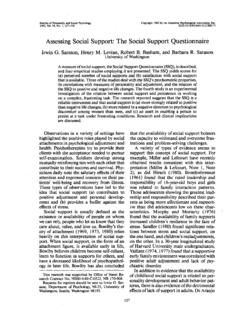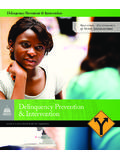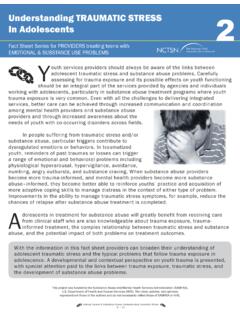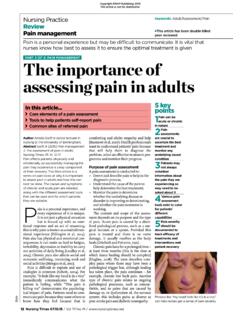Transcription of Assessing creativity: The Test for Creative Thinking ...
1 International Education Journal, 2005, 6(2), 272-280. ISSN 1443-1475 2005 Shannon Research Press. 272. Assessing creativity: The Test for Creative Thinking - Drawing Production (TCT-DP). Klaus K. Urban University of Hannover, Germany The Test for Creative Thinking - Drawing Production (TCT-DP), its design, concept and evaluation scheme as well as experiences and results of application are described. The test was designed to mirror a more holistic concept of creativity than the mere quantitatively oriented, traditional divergent Thinking tests. The specific design using figural fragments is explained. The drawing production is evaluated by means of a set of criteria, which at the same time represent the underlying test construct. The test has been normed with various age and ability groups; there were no significant differences between male and female subjects.
2 Various studies with data concerning the reliability and validity of the TCT-DP are provided. Creative Thinking , drawing production, holistic, development, gifted INTRODUCTION. Most traditional creativity tests give mere quantitative information about a very restricted aspect of creativity only. This was especially true for the two creativity tests which were published and available in Germany in the eighties, when first deliberations on the construction of a new instrument started. Both instruments, the Test zum divergenten Denken [Test for Divergent Thinking ] (TDK4-6; Mainberger, 1977) and the Verbaler Kreativit tstest [Verbal Creativity Test]. (VKT; Schoppe, 1975), were very much restricted as to their range of applicability. The TDK was standardised only for three Grades (4-6), the VKT may be used only with adolescents and adults from age 15 on with good school education, since the test only uses verbal material on a fairly high level.
3 Both instruments are relatively extensive in application and evaluation (time). The TDK lacks a theoretical basis; it consists of a not-founded or not-commented collection of various creativity tasks from the American tradition (Guilford; Torrance; Wallach and Kogan). The VKT- result is very much dependent on general verbal and intellectual abilities. Furthermore both tests are speed-tests, thus are close to intelligence tests as far as application is concerned. And both instruments refer solely to divergent Thinking respectively, more restricted only to the aspect of productivity, that is the quantity of mainly verbally determined ideas. These limitations in concept and scope of applicability were one reason for Urban and Jellen (1985; 1986; Jellen and Urban, 1986) to develop their new instrument, the Test zum sch pferischen Denken - Zeichnerisch (TSD-Z) (Urban and Jellen, 1995)1, or, in English, Test for Creative Thinking - Drawing Production (TCT-DP) (Urban and Jellen, 1996)2.
4 This assessment device may be seen as an attempt to apply a more holistic and gestalt-oriented approach to diagnostics of creativity. The German term sch pferisch' was chosen consciously in order to 1. The TSD-Z is available via or directly from SWETS Test Services, Frankfurt. 2. The TCT-DP is available from: under Children's tests : Thames Valley Test Company, Unit 22, Thurston Granary, Station Hill, Thurston, Suffolk, IP31 2QU, England, Tel. +44 (0)1359-232941, Fax -230581 or Urban 273. stress the shaping, the production, and the final gestalt' as the Creative end product. We wanted to consider not only divergent, or, still more limited, quantitative aspects, but aspects of quality, like content, gestalt, composition, and elaboration, too, and other components stressed in the literature, like (mental) risk taking and breaking of boundaries, unconventionality, affection, and humour.
5 DESIGN AND CONSTRUCTION. In designing and constructing the new assessment instrument, some premises should become realised: The test should be applicable to persons of a broad age range. It should work as a useful screening instrument in order to help to identify high Creative potentials as well as low Creative , neglected, and poorly developed ones. The instrument should be simple and economic in application, in conducting, scoring, and interpretation, economic in time and material. The test should be culture-fair. Because of a broad applicability, even to young children, and of an optimal culture-fairness we decided to operationalise our concept by means of a drawing production. According to the definition and consistent with the practical applicability of the test, the objectivity of the administration procedure, and for reasons of the availability of materials, of a common perceptional or informational basis, of comparability of the material presuppositions and conditions for different test takers, certain basic stimuli had to be designed and incorporated into the test.
6 One first stimulation for the design came from the additional subtest of the Heidelberger Intelligenztest (HIT) (Kratzmeier, 1977). The stimuli mentioned, in the form of figural elements or fragments, were intentionally designed in an incomplete and irregular fashion in order to achieve maximum flexibility as an imperative for creativity. Instead of concepts, symbols, or holistic figures, we decided to use figural fragments that possessed only vague conventional meanings. The completed drawing based more or less (creatively) on these fragments is evaluated by means of a set of categories that represent our theoretical construct of the assessment device. This important conceptual proposition, the simple, basic, unique design gives rise to a multitude of differing Creative responses as seen already in our first investigation of gifted and talented student populations as well as in the many thousands of drawings from persons of various age and ability levels from various countries.
7 At the same time, the given figural fragments must have enough suggestibility to trigger more stereotypical responses from students with lower degrees of creativity. These different possibilities for interpretation (that is, conventional vs. unconventional). lead to a higher selectivity and validity of the TCT-DP instrument. The test asks the testee to complete a drawing on the basis of some given figural fragments. These six figural fragments of the instrument were designed with the following points in mind. They are (1) different in design, (2) geometric and non-geometric, (3) round and straight, (4) singular and compositional, (5) broken and unbroken, (6) within and outside a (seemingly) given frame, (7). placed irregularly on the space provided, and (8) incomplete. An additional and extremely important element of the instrument is the big square frame'.
8 Together with the small open square' outside the large frame this boundary serves the purpose of providing information on the Creative component of risk-taking, which we operationalised as Boundary Breaking' in a twofold manner. The conceptual deliberations led to the following set of 14 key criteria that constitute as a whole the TCT-DP construct, and also serve as evaluation criteria (Jellen and Urban 1986; Urban and Jellen 1985, 1986): 274 Assessing creativity: The Test for Creative Thinking - Drawing Production (TCT-DP). 1. Continuations (Cn): Any use, continuation or extension of the six given figural fragments. 2. Completion (Cm): Any additions, completions, complements, supplements made to the used, continued or extended figural fragments. 3. New elements (Ne): Any new figure, symbol or element. 4. Connections made with a line (Cl) between one figural fragment or figure or another.
9 5. Connections made to produce a theme (Cth): Any figure contributing to a compositional theme or "gestalt". 6. Boundary breaking that is fragment dependent (Bfd): Any use, continuation or extension of the "small open square" located outside the square frame. 7. Boundary breaking that is fragment independent (Bfi). 8. Perspective (Pe): Any breaking away from two-dimensionality. 9. Humour and affectivity (Hu): Any drawing which elicits a humorous response, shows affection, emotion, or strong expressive power. 10. Unconventionality, a (Uc, a): Any manipulation of the material. 11. Unconventionality, b (Uc, b): Any surrealistic, fictional and/or abstract elements or drawings. 12. Unconventionality, c (Uc, c): Any usage of symbols or signs. 13. Unconventionality, d (Uc, d): Unconventional use of given fragments. 14. Speed (Sp): A breakdown of points, beyond a certain score-limit, according to the time spent on the drawing production.
10 If creativity transcends chaos through imposition of aesthetic order, then Creative process as well as Creative product must reflect the character of a "Gestalt" composition or the coherence of an organisation. Since "Gestalt" is more than the sum of its parts, the 14 key criteria cannot stand as single entities. Only as interacting factors do they together reflect a holistic concept of Creative thought. In statistical terms, a certain score on a single criterion says nothing about creativity; only the total score for all criteria indicates the value of the Creative product. The subjects are asked to complete the uncompleted drawing, somebody else had begun and finished without knowing what would come out of it, in whatever way they wish; everything is allowed and correct, they are free to draw how and whatever they wish.

















